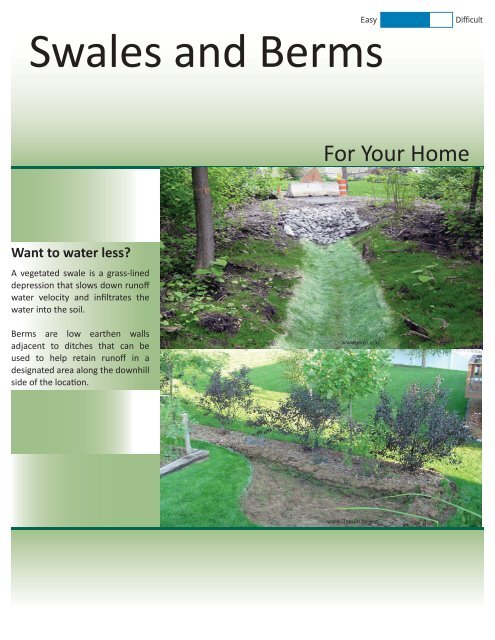Create successful ePaper yourself
Turn your PDF publications into a flip-book with our unique Google optimized e-Paper software.
EasyDifficult<strong>Swales</strong> <strong>and</strong> <strong>Berms</strong>For Your HomeWant to water less?A vegetated swale is a grass-lineddepression that slows down runoffwater velocity <strong>and</strong> infiltrates thewater into the soil.<strong>Berms</strong> are low earthen wallsadjacent to ditches that can beused to help retain runoff in adesignated area along the downhillside of the locaon.www.uvm.eduwww.lincoln.ne.gov
A vegetated swale is usually a grass-lined depression. Plants slow down runoff water velocity<strong>and</strong> infiltrate the water into the soil. <strong>Swales</strong> can be used to redirect rainwater runoff to rain gardens,tree pits, <strong>and</strong> dry wells.<strong>Berms</strong> can be used to help retain runoff in a designated area by piling up an appropriate amountof soil along the downhill side of the locaon. The berms do not need to be very big, usually fiveinches tall is sufficient for this purpose.Cold Climate Consideraons:See “Steps to create a berm” for examples of plants that will survive on a Fairbanks berm.Materials: Appropriate plants Extra soil if needed Non-toxic paint, stakes or string Nave plant seeds or grass seedsTools: Shovel Spade Measuring tapeSteps to create a vegetated swale:Steps to create a vegetated swale:1. Choose the right locaon for your swale:a. Note the direcon of runoff <strong>and</strong> low spots where water collects.b. <strong>Swales</strong> can be used to convey roof runoff to rain gardens, dry wells, or other areas of your lawn. <strong>Swales</strong>should not be used to direct runoff into the street or other nonporous surfaces.c. Make sure that the chosen locaon runs downhill <strong>and</strong> ends at least ten feet away from buildings withbasements.d. Locaon should not be on or near sepc tanks or wellheads.e. Before you dig, be aware of underground service lines or ulies on your property. Call 1-800-478-3121or go online at www.akonecall.com to have the underground lines marked for you.2. Once you have chosen a locaon, define the borders using non-toxic paint, stakes <strong>and</strong> string, etc.a. The swale can be as wide or narrow as you want it.b. The depth of the swale can be as deep as you like. For residenal purposes six inches or less isadequate.c. The slope of the swale should be not more than 3:1, horizontal to vercal.3. Remove the sod <strong>and</strong> dig a trench with the dimensions you wish your swale to be.4. Once you have finished your trench, either replace the sod or reseed the swale. You will need to water thesod or seeds well unl they are established.5. Aach a universal downspout adapter to the downspout <strong>and</strong> redirect it into the swale.Steps to create a berm:1. Pile up an appropriate amount of soil. Usually five inches tall is sufficient to retain water but not drown plants.2. Compact the soil by walking on it <strong>and</strong> tamping it down well.3. To help minimize erosion of the berms, either put a two-inch layer of mulch on the berm or plant drought resistantplants for ground cover. Rock Cress (Arabis arendsii), Gold Creeping Jenny (Lysimachia mummularia ‘Aurea’), <strong>and</strong>Field Pussytoes (Antennaria neglecta ‘Greene’) are some good choices.Maintenance:• Weeding• Ferlizing• Watering, frequently unl the vegetaon is established, then occasionally
Cost Esmate:• Self installed$3 - $7 per sq • Professionally installed$10 - $15 per sq Time Esmate:• This project could takeone to three days tocomplete.Pros:• Aesthecally pleasing.• Reduces water runoff.• Increases groundwaterinfiltraon.• Increases property value.• Creates habitat for birds <strong>and</strong>buerflies.Cons:• Surface freezingin the fall reducesthe water retenonpotenal during thatseason.• A restricted list ofsuitable plants.For more informaon about the Green Infrastructure Projectplease visit: www.cchrc.org/green-infrastructureSources:Alaska Department of Fish <strong>and</strong> Game, Nave Alaskan <strong>and</strong> Exoc Plants Used by Wildlifewww.wildlife.alaska.gov/index.cfm?adfg=birds.plantsTree People website, Build <strong>Berms</strong>www.treepeople.org/build-bermsUnited States Environmental Protecon Agency website, Naonal Pollutant Discharge Elimina-on System, Grassed <strong>Swales</strong>hp://cfpub.epa.gov/npdes/stormwater/menuomps/index.cfm?acon=factsheet_results&view=specific&bmp=75



